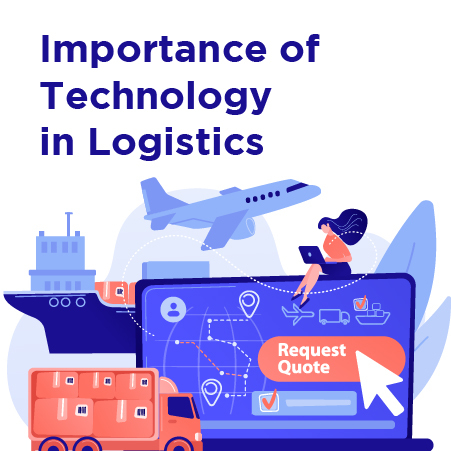
Technology transforming the Logistics sector
There were times when businesses did not reinvent themselves frequently. If something was working fine, no one tried to innovate to make things better.
But technological leaps in the last couple of decades of the new millennium have changed the game of, and for, businesses. Forever.
Companies have to necessarily embrace change and deep dive into the internet of things (IoT) space to become leaner, more efficient, more customer-focused and more profitable.
The logistics industry is no exception.
In the logistics space, technology has revolutionized supply chains. So, productivity has gone up, errors are minimal and costs have come down substantially. Technology has had a sweeping impact on all dimensions of the logistics business: This includes transportation by road and rail, by sea and air, supply chain management and shipment management.
Traditionally, for years, in fact, the logistics business was infamous for bottlenecks and complicated processes. Shipments were often difficult to trace. And reports on delays were never forthcoming. But first barcodes, then RFID, and now, complete cutting-edge logistics management systems offer real-time information and updates.
Technology has changed the face of the logistics business. Completely.
How IoT will drive the logistics space going forward
With access to high-speed internet now a given, Wi-Fi capability in devices and vehicles is transforming the logistics business. Driverless vehicles, with electronic eyes and ears, are already a reality; they can function without any human input or involvement. Google’s vision to make driverless electric vehicles and IoT’s ability to enable everything with Wi-Fi is filling the supply chain with new efficiencies and possibilities.
Self-driving trucks: Trucks can now be driven without humans manning them. Tesla, Uber and Embark have all tested driverless, self-driving, trucks.
AI and machine learning: Machine learning is a branch of artificial intelligence that is elevating the supply chain to a whole new level of efficiency and precision. AI helps in a) taking tons of data that a supply chain typically generates and b) converting the data to useful information that enables quick decision-making. AI, therefore, is generating huge savings – on costs and time – in the supply chain. Manual tasks that were once ridden with mistakes are almost eliminated and entire workflows and processes are now automated.
Leveraging the power of social media: Logistics companies have taken to social media platforms the way fish take to water. They leverage social media to engage with customers meaningfully by offering them real-time updates, making important announcements and collecting critical feedback. In fact, courses on logistics management these days have a separate module on how companies and professionals can leverage the power of social media. This underlines the importance of social media in the logistics business.
The profound impact of blockchain technology: The process of tracking shipments, from despatch to delivery, at every stage of the logistics journey, has been greatly simplified by blockchain technology. These days, logistics applications store, retrieve, and use critical data in the supply chain, and provide automated approvals using the smart contract system, to manage the entire logistics life cycle of a shipment. From the time it leaves the manufacturer to the time it reaches the client, the shipment’s entire journey is managed seamlessly.
The key to thrive in the logistics industry
With technology offering an edge, logistics companies are focused on enhancing their efficiency. Because higher efficiency, at lower cost, alone holds the key to growing and thriving in this industry.
Consider this: There are more vendors, more customers, and more supply routes in play in the logistics space than ever before. How does a player stay competitive in what appears to be a shark-infested, bloody, red ocean? Clearly, having a sound strategy on a PowerPoint deck and a business plan that looks good on a Microsoft Excel spreadsheet are just not going to be enough.
Companies need to use technology to gain an edge on these critical operational parameters:
- Their supply routes need to be optimized. If they are not, operating costs will be higher and profit margins will be lower.
- The supply chain network must be integrated using an application or software program that deploys blockchain technology. Investing in a transportation management system makes sound business sense. A robust, contemporary system saves costs, enhances visibility of the entire supply chain and increases productivity and operational efficiency.
- Listening to and communicating with the customer base in real time is of utmost importance. Disruptions to the supply chain can happen due to natural or human factors at any time. Smart logistics companies are always on the ball and communicate with their customers quickly and transparently.
Technology is a great enabler. And in the logistics space, it is enabling innovation like never before. Companies that were focused only on penetrating a market in the past are now using technology to retain market share. This has been made possible because innovative logistics management systems and solutions are available aplenty for companies today.
Also Read: Top Logistics Companies In India
When all the pieces fall into place
As the logistics industry embraces and adapts to the transformational power of technology, many moving parts in the business are now in better sync with each other. For instance, the transportation management systems of various players are beginning to have the ability to adapt seamlessly. People are more trained and knowledgeable today to operate these systems than they were in the past. New talent joining the business comes equipped with relevant knowledge and skills from attending educational courses that are up-to-date with developments in the industry. Deliveries are getting done faster these days, and, importantly, they are being achieved at lower costs. More pieces of the logistics business are being upgraded and automated at a remarkable speed.
As all the elements fall into place, the new, improved, logistics industry looks transformed: It is more efficient, it is leaner, it is more profitable and it is more fun to be a part of!








